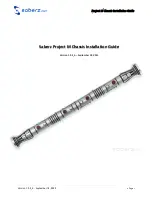
Chassis Level Storage Enclosures
•
HDD motherboard enclosure
—The 56 dual port disk slots in the chassis comprise the HDD
motherboard enclosure.
•
HDD expansion tray
—The 4 additional dual disk slots in the Cisco UCS S3260 system comprise
the HDD expansion tray.
The HDD expansion tray is a field replaceable unit (FRU). The disks will remain
unassigned upon insertion, and can be assigned to storage controllers. For detailed
steps on how to perform disk zoning, see
Disk Zoning Policies, on page 9
Note
Server level Storage Enclosures
Server level storage enclosures are pre-assigned dedicated enclosures to the server. These can be one of
the following:
•
Rear Boot SSD enclosure
—This enclosure contains two 2.5 inch disk slots on the rear panel of
the Cisco UCS S3260 system. Each server has two dedicated disk slots. These disk slots support
SATA SSDs.
•
Server board NVMe enclosure
—This enclosure contains one PCIe NVMe controller.
In the Cisco UCS S3260 system, even though disks can be physically present on the two types of
enclosures described above, from the host OS all the disks are viewed as part of one SCSI enclosure.
They are connected to SAS expanders that are configured to run as single SES enclosure.
Note
Storage Controllers
Mezzanine Storage Controllers
The following table lists the storage controller type, firmware type, modes, sharing and OOB support
for the various storage controllers.
Table 2:
OOB Support
Sharing
Modes
Firmware type
Storage Controller
Type
Yes
No
HW RAID, JBOD
Mega RAID
UCSC-S3X60-R1GB
Yes
No
HW RAID, JBOD
Mega RAID
UCS-C3K-M4RAID
Yes
Yes
Pass through
Initiator Target
UCSC-S3X60-HBA
Yes
Yes
Pass through
Initiator Target
UCS-S3260-DHBA
Other storage controllers
SW RAID Controller
—The servers in the Cisco UCS S3260 system support two dedicated internal
SSDs embedded into the PCIe riser that is connected to the SW RAID Controller. This controller is
supported on the Cisco C3000 M3 servers.
Cisco UCS S3260 System Storage Management
7
Cisco UCS S3260 System Storage Management
Storage Server Features and Components Overview




















